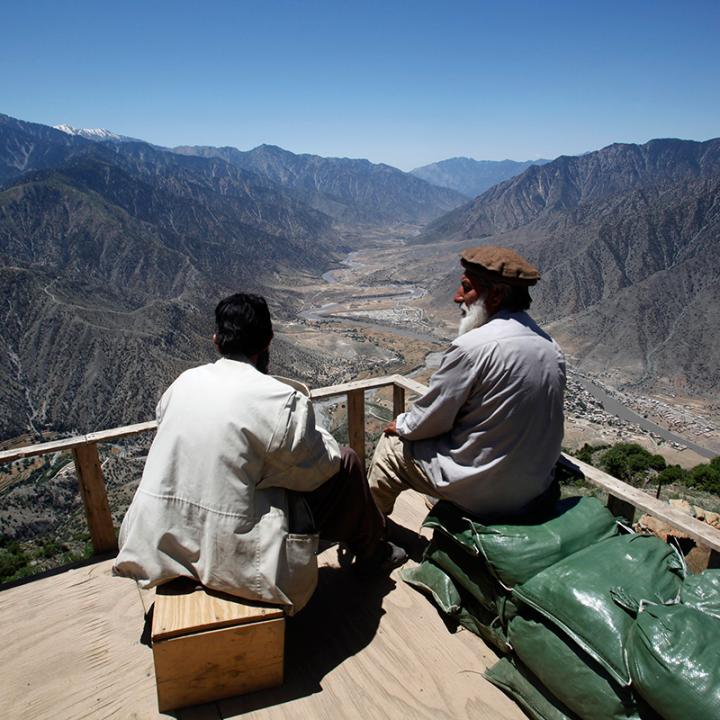

The U.S. withdrawal from Afghanistan could mean heightened activity from terrorist organizations other than the Taliban.
With the U.S. military withdrawal from Afghanistan ongoing, the Taliban is likely to take over much of Afghanistan. The lack of United States air support for the Afghan Army and the absence of U.S. contractors to maintain Afghan Air Force aircraft will be devastating.
In addition to the clear dangers for the Afghan people, the risk of Taliban rule is not that they themselves will engage in terrorism abroad, but rather that Taliban leadership could be largely indifferent to plots by al-Qaeda and Islamic State in Afghanistan (IS/A) against international targets—in contrast to the efforts of the current Afghan government. With this in mind, it is worth examining how much of a threat these two organizations represent—both in Afghanistan and in the broader Middle East region.
Al-Qaeda in Afghanistan and Pakistan (AQ in A/P)
Al-Qaeda in Afghanistan and Pakistan (AQ in A/P) is not the organization that it was under Osama Bin Laden. The United States has killed many of the organization’s operatives, its current leader Ayman al-Zawahiri is rumored dead, and many others in its leadership are on the run. Bin Laden’s death also led to a decline in funding for organization activity, which Bin Laden had successfully generated. As a result, there are no longer large-scale training camps in Afghanistan in the manner that existed before 9/11.
Nevertheless, a UN report estimates that AQ still has about 400-600 members in the country who periodically fight alongside the Taliban and engage in fund-raising and bomb making. There are also many social ties between the two organizations through marriage between the two groups.
In an attempt to address this issue, U.S. negotiators have pressed the Taliban for years to prevent al-Qaeda from using Afghanistan as a haven for international attacks. The Taliban claims to have accepted this demand, and al-Qaeda members have also said publicly that they will abstain from such attacks. However, encouragement for international attacks has persisted despite promises from both the Taliban and AQ.
A recent incident sheds additional light on AQ’s ambitions. In October 2020, Afghan special operations forces killed Abu Muhsin al-Masri, likely the number two AQ member in Afghanistan and a name on the FBI's most wanted terrorists list for several years. According to Afghan intelligence officials, during the raid, the special operations forces discovered al-Masri’s messages telling AQ counterparts in Syria that Afghanistan could soon return to its pre-9/11 position as a central hub for the terror group. Moreover, two U.S. air strikes against al-Qaeda targets in Syria's Idlib province quickly followed the raid, leading to speculation that al-Masri’s messages also incriminated AQ members in Syria in plotting against U.S. targets.
The Islamic State in Afghanistan
In contrast to the cooperation with AQ in A/P, the Islamic State—Khorasan (IS-K) has taken an adversarial position against the Taliban. Both organizations seek to overthrow the Afghan government, but, despite this shared ambition, they have fought with each other periodically in eastern Afghanistan where the IS/A is based.
According to the aforementioned UN report, IS-K has about 2,200 armed fighters concentrated in the mountainous Kunar Province near the Pakistan border. Most of its members are remnants of Pakistani Pashtun militants who fled Pakistani security forces into Afghanistan. The force also consists of Afghan Army defectors and Uzbek militants.
These disparate militants teamed up with the Islamic State in Iraq and Syria beginning in 2014, and small numbers of ISIS Arab militants in Iraq and Syria have subsequently sought refuge in Afghanistan. The Iraqi contingent of the Islamic State has also donated modest amounts of money to its Afghan branch. However, the various branches of the Islamic State currently maintain limited communication confined to cellphone messaging between the Afghanistan branch and other branches in the region.
The Terrorist Threat in Afghanistan after the U.S. Withdrawal
With the imminent withdrawal of U.S. and coalition international forces, the southern and eastern parts of Afghanistan—about 40-50 percent of the country’s area and including the city of Qandahar—are likely to come under Taliban rule. This portion of the country is largely Pashtun, the ethnic base from which the Taliban draws most of its recruits. Pashtuns also represent about 45 percent of the total Afghan population, and the areas where they represent the majority are the most likely to be used by AQ and IS-K to establish new training bases following the U.S. withdrawal.
The northern and western parts of Afghanistan are likely to degenerate into armed clashes between the Taliban and non-Pashtun militias. Tajiks, representing about 25 percent of the total Afghan population, are the majority ethnic group in the large cities of Mazar Sharif in the north and Herat in the west. Hazaras, who are the country’s only Shia ethnic group, represent about 10 percent of the Afghan population and are the majority in rural central Afghanistan. Uzbeks and Turkmen, both Turkic peoples, represent about 10-15 percent of the Afghan population and live mainly in the north. While most densely populated in southern and eastern parts of Afghanistan, the pockets of Pashtuns in the rest of the country could become centers of AQ and IS-K activity.
Perhaps most uncertain is the future of Kabul and its environs. Without any direct support from U.S. forces, the fate of the greater Kabul region will be dependent on the performance of the Afghan Army. While the majority of the Afghan Army is a mediocre fighting force, its Special Operations forces—about 10 percent of the army as a whole—are excellent. The United States also currently provides about $5 billion a year in military and humanitarian aid. The survival of the Afghan government and army will require continued international financial support of these forces in particular; even then, there are no guarantees of success.
Another option for supporting the Afghan military personnel is external training opportunities; Jordan has been mentioned as one option. However, the potential consequences of lost funding and training support are exemplified by the collapse of the communist Afghan government under Najibullah. His regime hung on after Soviet forces withdrew in 1988-89, but collapsed after Moscow ended its financial support in 1991.
It is true that if the Taliban takes over most of Afghanistan, the United States will still have a military reach, however limited, into Afghanistan. This reach will allow them to continue combatting AQ, the Islamic State, and other hostile forces in the event of attacks against Americans or their partners. U.S. aircraft would have to use its military base in Qatar and its aircraft carriers off Pakistan for post-withdrawal excursions into Afghanistan.
However, the distances are considerable and U.S. aircraft would not be able to spend an extended amount of time searching for targets. Moreover, Russia is likely to dissuade the Central Asian governments from providing the United States use of their military bases for counter-terrorism strikes, a marked difference from the counterterrorism cooperation between the U.S. and Russia in the early 2000s. Pakistan does not seem enthusiastic about providing the U.S. the use of military bases there.
Besides U.S. led military operations launched from other allies’ territories, the United States and other countries could also respond to terrorist attacks by delegating the tracking down of those responsible to the Afghan military. However, this option is only viable as long as the Afghan military apparatus is still functioning. Otherwise, the United States would have to resort to threatening the Taliban government with retaliation unless the latter cracks down on international terrorists on its soil or hires Afghan mercenaries to seek out the culprits.
Moreover, U.S. intelligence capabilities will be greatly diminished once its forces withdraw from the country. While there will be a modest human and technical intelligence capacity at the U.S. embassy in Kabul—assuming that there is a U.S. embassy there—it would not be the same as having intelligence assets throughout the country. The deterioration of U.S. intelligence will greatly undermine the military effectiveness of whatever U.S. military options remain, as well as the ability to assist the Afghan National Army. Afghanistan will again become a distant and opaque country.
In any case, the U.S. government should be prepared for the likelihood that international terrorist groups will be emboldened by the withdrawal of the United States from Afghanistan. The Taliban flag flying over Kabul will act as an inspiration for militants throughout the Islamic world—while instilling fear and sometimes terror for many Afghans.


